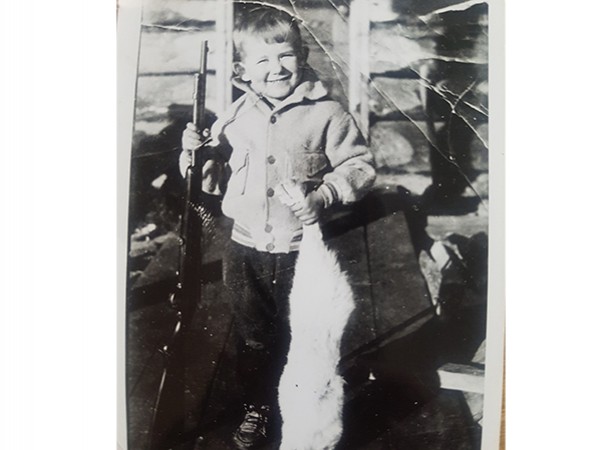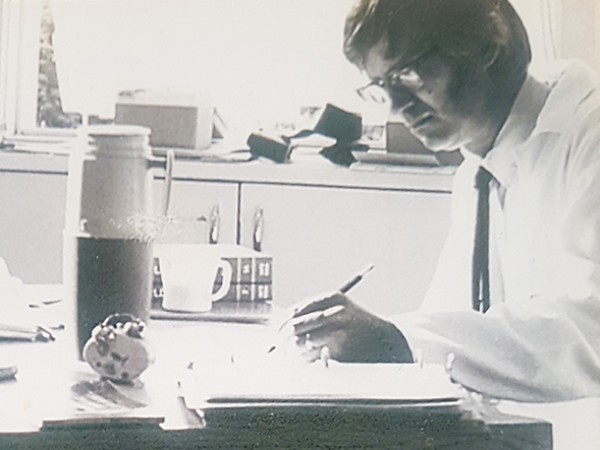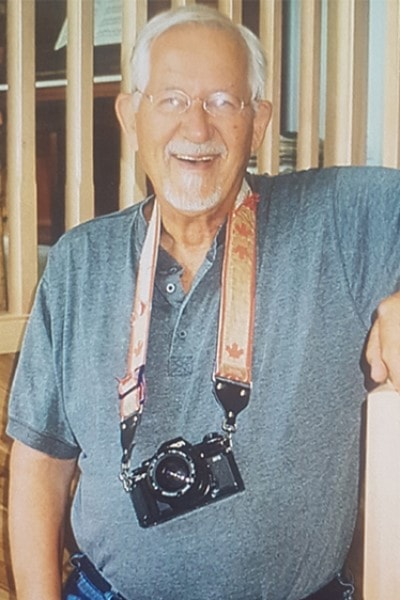Helge Ronald Larsen
Photographer.
Nature lover.
Musician.
And most of all... Teacher.
A tribute by Roxi Harms, family friend and former student.
Born July 20, 1931 in Burns Lake BC to Effie (Anderson) and Harry Larsen; passed away peacefully on April 2, 2020 in Comox BC, aged 88.
Helge's childhood home, a trapping cabin up the railway line a little from Burns Lake and set back in the bush between Decker Lake and Palling, had grown into a conglomerate of additions with a bit of porch here and a little tarpaper there by the time Helge and his six younger sisters had come along. The kitchen, where all the living happened, was a big room with a long oilcloth-covered table down the middle, men at one end, near the window, and women and children at the other, near the cookstove.
Being the eldest child and only son of a trapper, Helge had already been practicing on his own little trapline for a season or two before he began first grade. With his father away more often than not, he had plenty of reason to learn to snare or shoot something edible for the supper pot. And when there was a rabbit to spare, he carried it to school for the stew that bubbled away during morning lessons on the tin stove of the one room schoolhouse at Palling.
As Helge grew into a teenager, nature and necessity converged as he took on the role of disciplinarian to his six younger sisters. "More of a father figure," is how they often describe Helge when asked, even now. But if he was the boss of the clan, he was also the jokester and sometimes a torturer as only an older brother can be. Goading the little girls into running up and down the wooden staircase in their nightgowns, skipping over the lit candles that he'd placed on alternating stairs was good entertainment for a teenage boy living in the bush with a lack of recreation.
An entrepreneurial streak, perhaps inherited from his dad, led Helge into many creative ventures as he began to yearn for that sweet hint of independence a little cash brings at that age. Perhaps his best-known enterprise began when he spotted a magazine advertisement enticing readers to become representatives for a refreshing new drink mix called "Very Best." Soon the Larsens' weekly mail, collected at the train station just a few miles away, was filled with packages of sugary drink crystals. The Very Best Man of Palling had been born. Each month for a full spring, summer, and fall, Helge walked his multi-day route, delivering the goods to his customers, rain or shine.
His career as a chicken farmer didn't turn out as well. With visions of an egg selling empire, Helge ordered 100 one-day-old chicks, collected them from the train station, and lovingly tended his flock as they developed from fluff balls into young pullets covered in pin feathers. One fateful day in late spring a third of the flock perished, never having laid their first egg, after quenching their thirst on the anti-freeze dumped in their water trough by a careless and annoying younger sister. Devastated, Helge sold the Helge's first full time teaching position and where he would spend the majority of his career, was a Grade 4,5,6 class at Grassy Plains School on the south side of Francois Lake. It was the early 1950's. Living in a teacherage behind the school, he relished his work, challenging himself to come up with interesting assignments to engage his students. The kids responded. Other teachers noticed. He was good. Over the years many colleagues and many students would regard Helge as one of the best teachers they'd ever known.
Independent and carefree, with a job he loved, the perfect life was unfolding for Helge. During the week he worked hard. On weekends he played hard. Like most young men since the Model T, Helge's first really big purchase as a young adult had been a car. During his years as an eligible young bachelor, he owned a Ford Meteor and a number of Thunderbirds, and could often be seen polishing them in preparation for the weekend. In the winter of 1959 on the icy corners of Priestly Hill, Helge's plans for a weekend of fun in Prince George slammed to a halt as the car he was driving collided with a Greyhound bus. Thankfully, passengers in both the car and the bus were uninjured. Moved off the road into the warmth of the bus by the good Samaritans at the scene Helge was dazed from the impact of his face and head on the steering wheel, but seemed otherwise okay. Then tragedy struck. A clot dislodged by the move triggered a severe stroke. When he regained consciousness weeks later, the dashing young 28-year-old school teacher couldn't walk, speak, or move his right arm.
The time following the accident was a blur of friends and family drifting in and out of the room, doctors and nurses poking and prodding, people murmuring to one another around his bed. At some point in that fog, Helge heard his father's voice. "Don't see how he'll ever come out of this. We're never gonna see him again," his dad said. Helge wasn't ready to die though, and he began to fight. He remembered those words his whole life.
When he was stable, the doctors moved Helge to the G.F. Strong Centre in Vancouver for rehabilitation. The neurological assessment confirmed a diagnosis of aphasia, the inability to express oneself using language, and extensive right-side paralysis. A program was designed to teach him to speak, function in a wheelchair, and perform basic tasks with his left land.
Helge, however, had other plans. Surpassing all expectations of his medical team, he took his first steps a few months later and walked, albeit haltingly, out to the car when he was discharged. Continuing his convalescence, he lived first with his sister Sheila's family in Burnaby, and later with Effie and his younger sisters who had relocated to Summerland. He pushed himself ruthlessly. With determination and grit, he struggled up and down the stairs to his room, spent hours alone doggedly practicing his printing and writing, rehearsed the pronunciation of new words each day, and worked in the garden for long stretches to retrain his brain into left-handed dominance. Paintings from his art therapy during this time hung above the piano in the family home years later.
Two and a half years after his accident, Helge wrote to the school board. He was ready to teach again. That fall, he was back in the classroom. He would teach another two and a half decades.
He'd been back to work for a few years when he saw Marge Fehr at a Christmas party she was attending with her parents. They'd been introduced briefly at his sister's home in town where Marge babysat, and Helge went over to say hello. At the end of the night, he asked Mr. Fehr if he could drive Marge home. Soon they were dating steadily, and the following year they married and settled into the teacherage together. Daughters Roni Lynn and Lori Joan, whom Helge later called his best accomplishments in life, were born in 1968 and 1970.
Helge and Marge both loved being active and being outdoors. In the summer of 1973, the couple (Helge with the use of only one arm) cycled from Grassy Plains to Terrace for a holiday while the girls rode the bus and stayed with relatives until their young, fit parents arrived. Gardening was another shared love. Religiously each winter Helge and Marge poured over the Stokes catalogue to decide on the season's order. All plants, flowers as well as vegetables, were best when started from seeds.
When the gardening was all done, and the lesson plans for the next day had been prepared, Helge took the girls for walks with frequent stops to photograph flowers, trees, small animals - any of mother nature's wonders that caught his eye. Afterwards, in the darkroom he'd set up in the bathroom, with a fold down table and special light-blocking material for the window, the pictures would be bathed and clipped onto lines over the bathtub to dry. Everyone knew that when that door was shut, it was not to be opened or the consequences would be dire. If they were already in before he started though, Helge would lift his little daughters onto the bathroom counter and patiently explain what he was doing, as they watched in fascination.
The girls grew and Helge began looking around for a bigger home. In 1979 the family purchased a home on 80 acres at the top of Southbank Hill where they lived for nearly a decade. With space to spare, Helge and Marge expanded their gardens and shared summers outdoors tending a vast array of flower beds, a large greenhouse, and a vegetable garden. Helge continued to teach at Grassy, with a couple of years at Southbank Elementary thrown in the mix. Long evenings at his desk at the school or marking papers at the kitchen table at home were testament to his tireless commitment to his students. Preparing the classroom for each new term, and setting up for new projects that he created regularly were family affairs, with Marge and the girls joining Helge in the classroom to help him get things just right.
In 1986, Helge retired from teaching. Soon after, he and Marge decided to separate. Facing a new phase of life which was essentially a blank canvas, Helge's focus switched to travel and he began to feed an appetite whetted by a long summer in Scandinavia a few years earlier. Australia, New Zealand, and Europe with their rich histories and endless photographic opportunities were among his international destinations. His own family history back in Norway and Sweden was a topic of fascination in which Helge took the time to indulge in these years, locating and getting to know many relatives and the stories they possessed about his heritage and the homelands that had shaped his parents as youngsters.
After several years of international exploration, Helge's sights turned homeward. He wanted to experience more of Canada. A motorhome would not only be economical, it would allow him to reach and immerse himself in the rugged beauty of the remote areas of Canada. A home on wheels was selected and outfitted, and soon he was criss-crossing Canada, seeking out less trodden routes like the Labrador Highway, one of his all-time favourites. Setting up camp wherever and for however long he wished, playing classical music at maximum volume while he rolled down the open road, Helge racked up miles and boxes of film to be processed in the next town. And when he'd satiated that thirst, Vancouver Island became his next and final frontier. Camping up and down the island during the summer in his trusty motorhome, capturing the beauty around him in photographs, and settling in somewhere for a few months each winter, Helge was content.
Eventually, after nearly two decades of travel, he'd had enough of life on the road. Settled into an apartment in Comox, he could again plant and nurture his favourite and always some new varieties of flowers, filling a patio that was the envy of the building. Each fall, the seeds were carefully gathered and saved to be replanted the following spring. Days were filled with gardening and reading up on new gardening techniques, CBC radio and classical records (the latter ofttimes resulting in a noise warning from the landlord), visits with his daughters, grandkids, sisters, old friends, and grown students, and making cards adorned with his favourite photos to mail out to those who had been to visit and those he wished would.
Helge lived a life in tune with the world around him. He identified with nature, with birds, with people around the world. He understood the weather and the seasons, and when and how to plant innumerable varieties of flowers, vegetables, and herbs. During his career, he understood his students, recognizing where they were at, where they could be, and how to help them get there. He knew how to use natural light to create the most beautiful images and how to use the mechanics of the camera in perfect concert with the lighting conditions and the subject of the photo. A diehard socialist, he was concerned about the state of the world, and the damage mankind is doing to mother earth.
Family became increasingly important to Helge in his latter years. Visits from his sisters were rewarded by meals of "home food," including his signature dishes of Swedish meatballs and clam chowder. His daughters and grandchildren lit up his world. Marge's tragic death, eight months before his own, saddened him to his core.
A few of the things Helge will be remembered for are his incredible photography of nature and people, his remarkable skill as a one-handed pianist, and his long-distance aim with a piece of chalk (as accurate with his left hand as it had ever been with his right). Those who had Mr. Larsen as a teacher, and there are many, will remember key lessons he taught, from the consequence of misbehaving to the stages of embryonic development of a chick inside an egg, from the geography of Canada to the importance of brushing one's teeth after lunch.
Helge passed away peacefully at home in Comox on a day and time of his own choosing, reminiscing and joking about happy memories with the family that surrounded his bed. He is predeceased by his parents and his sisters Evelyn and Lorna. He is survived by his sisters Thora, Sheila, Lilian, and Lynn, his daughters Roni and Lori, and his grandchildren Kyle, Madison, Dylan, Spencer, and Maxx.
The legacy of Helge Larsen is expansive - in the memories of his sisters and his daughters and their children, in the immense photographic history that lives in his vast collection, and in the hearts and minds of the many, many children and young teenagers he taught over two generations. Many a conversation between old friends or classmates, or new friends who discover a common history in the Burns Lake and Southside area, at some point, lands on Helge. And thus, he lives on far and wide. Rest in peace Helge.
Some description of the early home taken from The Wrong Highway, The Misadventures of a Misplaced Society Girl, by Stella T. Jenkins
To see Helge's life in pictures, go to his Facebook page at https://www.facebook.com/helge.r.larsen
Additional Photo(s):


